
The Spanish missions in California formed a series of 21 religious outposts or missions established between 1769 and 1833 in what is now the U.S. state of California. The missions were established by Catholic priests of the Franciscan order to evangelize indigenous peoples backed by the military force of the Spanish Empire. The missions were part of the expansion and settlement of New Spain through the formation of Alta California, expanding the empire into the most northern and western parts of Spanish North America. Civilian settlers and soldiers accompanied missionaries and formed settlements like the Pueblo de Los Ángeles.
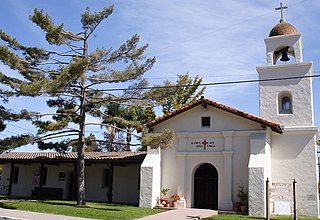
Mission Santa Cruz is a replica Spanish Californian mission in Santa Cruz, California. Located at the foot of a what would later be named Mission Hill, the original mission was founded on August 28, 1791, by Father Fermín Francisco de Lasuén, the successor of Father Junipero Serra. The mission was dedicated that same year, and in the winter, the waters of the San Lorenzo River flooded its banks, and caused extensive damage to the original building, and so the mission was relocated to the top of Mission Hill. After earthquake damage and years of neglect, this second mission fell into disrepair, and much of it, though not all, was removed to accommodate the construction of the Holy Cross Church. The Holy Cross Church paid for the construction of the replica in the 1930s, and today it functions as a historical monument and chapel for the parish.

Mission San Fernando Rey de España is a Spanish mission in the Mission Hills community of Los Angeles, California. The mission was founded on 8 September 1797 at the site of Achooykomenga, and was the seventeenth of the twenty-one Spanish missions established in Alta California. Named for Saint Ferdinand, the mission is the namesake of the nearby city of San Fernando and the San Fernando Valley.

Mission San Luis Rey de Francia is a former Spanish mission in San Luis Rey, a neighborhood in Oceanside, California. This Mission lent its name to the Luiseño tribe of Mission Indians.
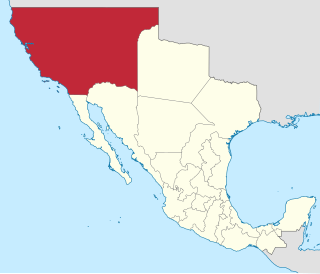
Alta California, also known as Nueva California among other names, was a province of New Spain formally established in 1804. Along with the Baja California peninsula, it had previously comprised the province of Las Californias, but was made a separate province in 1804. Following the Mexican War of Independence, it became a territory of Mexico in April 1822 and was renamed Alta California in 1824.
The Pueblo Revolt of 1680, also known as Popé's Rebellion or Po'pay's Rebellion, was an uprising of most of the indigenous Pueblo people against the Spanish colonizers in the province of Santa Fe de Nuevo México, larger than present-day New Mexico. Incidents of brutality and cruelty, coupled with persistent Spanish policies such as those that occurred in 1599 and resulted in The Ácoma Massacre, stoked animosity, gave rise to the eventual Revolt of 1680. The persecution and mistreatment of Pueblo people who adhered to traditional religious practices was the most despised of these. Scholars consider it the first Native American religious traditionalist revitalization movement. The Spaniards were resolved to abolish "pagan" forms of worship and replace them with Christianity. The Pueblo Revolt killed 400 Spaniards and drove the remaining 2,000 settlers out of the province. The Spaniards returned to New Mexico twelve years later.
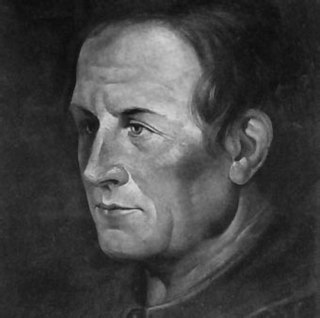
Eusebio Francisco Kino, SJ, often referred to as Father Kino, was an Italian Jesuit, missionary, geographer, explorer, cartographer, mathematician and astronomer born in the Bishopric of Trent, Holy Roman Empire.
Toypurina (1760–1799) was a Kizh indian medicine woman from the Jachivit village. She is notable for her opposition to the colonial rule by Spanish missionaries in California, and for her part in the planned 1785 rebellion against the Mission San Gabriel. She recruited six of the eight villages whose men participated in the attack.

The Spanish missions in Baja California were a large number of religious outposts established by Catholic religious orders, the Jesuits, the Franciscans and the Dominicans, between 1683 and 1834. The missionary goal was to spread the Christian doctrine among the Indigenous peoples living on the Baja California peninsula. The missions gave Spain a valuable toehold in the frontier land, and would also act as a deterrent to prevent pirates from using the peninsula of Las Californias as a jumping off point for contraband trade with mainland New Spain. Missionaries introduced European livestock, fruits, vegetables, and industry into the region. Indigenous peoples were severely impacted by the introduction of European diseases such as smallpox and measles; furthermore, the expulsion of the Jesuits from the Spanish Empire in 1767 ripped the social fabric of the peninsula, although Franciscans were sent to replace them. In 1769, the Franciscans moved to Upper California, leaving Dominicans in charge of Baja California. By 1800 indigenous numbers were a fraction of what they had been before the arrival of the Spanish, yet even today many people living in Baja California are of indigenous heritage.

Mission Indians was a term used to refer to the Indigenous peoples of California who lived or grew up in the Spanish mission system in California. Today the term is used to refer to their descendants and to specific, contemporary tribal nations in California.

The Acjachemen are an Indigenous people of California. Published maps often identify their ancestral lands as extending from the beach to the mountains, south from what is now known as Aliso Creek in Orange County to the Las Pulgas Canyon in the northwestern part of San Diego County. However, sources also show that Acjachemen people shared sites with other Indigenous nations as far north as Puvunga in contemporary Long Beach.
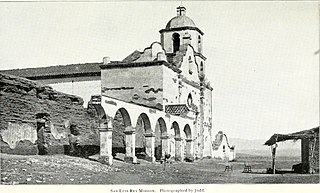
The history of slavery in California began with the enslavement of Indigenous Californians under Spanish colonial rule. The arrival of the Spanish colonists introduced chattel slavery and involuntary servitude to the area. Over 90,000 Indigenous peoples were forced to stay at the Spanish missions in California between 1770 and 1834, being kept in well-guarded mission compounds. This has been described as de facto slavery, as they were forced to work on the mission's grounds amid abuse, malnourishment, overworking, and a high death rate. Indigenous girls were taken from their parents to be housed in guarded dormitories known as monjeríos for conversion to Catholicism and control over their sexuality.
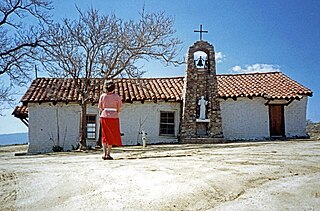
Warner Springs is set of springs and a small unincorporated community in northern San Diego County, California. It is on the Pacific Crest Trail.
The California mission clash of cultures occurred at the Spanish Missions in California during the Spanish Las Californias-New Spain and Mexican Alta California eras of control, with lasting consequences after American statehood. The Missions were religious outposts established by Spanish Catholic Franciscans from 1769 to 1823 for the purpose of protecting Spain's territory by settlements and converting the Californian Native Americans to the Christian religion.
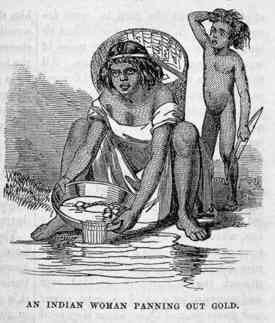
Forced labor of Native Americans in California spanned from the Spanish missions of the 18th century to the gold rush era of the mid-19th century. Native Californians were subject to systematic exploitation, forced labor, and cultural disruption.

The Mexican Secularization Act of 1833, officially called the Decree for the Secularization of the Missions of California, was an act passed by the Congress of the Union of the First Mexican Republic which secularized the Californian missions. The act nationalized the missions, transferring their ownership from the Franciscan Order of the Catholic Church to the Mexican authorities.

Kaawchama, alternatively referred to as Wa’aachnga, was a significant Tongva village in the San Bernardino Valley located in what is now west Redlands, California. The village became referred to by the Spanish as the Guachama Rancheria in 1810 after a supply station was constructed at the village for Mission San Gabriel, which then became part of Rancho San Bernardino following the secularization of the missions in 1833.

Pedro Ortiz de Zárate was an Argentine Catholic priest and Giovanni Antonio Solinas, SJ was an Italian Catholic priest in the Society of Jesus.
Comicranga was a coastal Tongva village located at what is now the area of Santa Monica, California. It is most notable as the home village in the early 19th century of Bartolomea, better known as Victoria Reid after her second marriage. She was a respected Indigenous woman in Mexican California, who was among the few indigenous people to receive a land grant. As a young widow, she married Scottish immigrant Hugo Reid, who became a naturalized Mexican citizen. The village is referred in various records and spellings to as Comigranga, Comicraibit, Comicrabit, and possibly Coronababit.
Victoria Reid, also known as Bartolomea Comicrabit, was an indigenous Tongva woman from the village of Comicranga, at what is now Santa Monica, California. She is notable for having been one of the few Indigenous people to be granted land by the Mexican Republic, and for having respected social status in Mexican California. She is also notable for her marriage as a widow to Hugo Reid, a Scottish immigrant who became a naturalized Mexican citizen. After her marriage to Reid, she was known as "Victoria", and referred to respectfully as Doña Victoria.



















